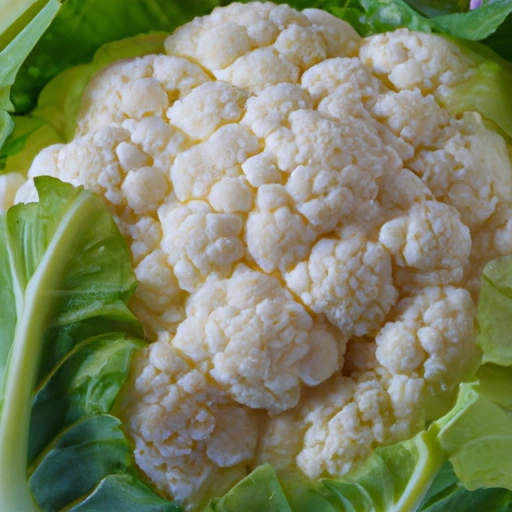Cauliflower
Description

Cauliflower is a highly versatile and nutritious vegetable that belongs to the species Brassica oleracea, which also includes broccoli, kale, and cabbage. It consists of tightly clustered white florets, often referred to as 'curds,' that form a dense head, commonly called a 'crown,' surrounded by green leafy stalks. Cauliflower is harvested for its edible head, which can be consumed raw, cooked, or pickled. It is a popular ingredient in various cuisines around the world and is celebrated for its ability to absorb flavors and adapt to a multitude of cooking methods.
Common uses
Cauliflower is commonly used as a low-carb substitute in dishes like pizza crusts, rice, and mashed potatoes. It is also enjoyed roasted, steamed, stir-fried, or baked, and is a frequent ingredient in soups, curries, salads, and as a side dish. Additionally, cauliflower can be pickled or used in relishes and is increasingly popular in vegetarian and vegan cuisine as a meat substitute due to its hearty texture.
Nutritional value
Calories
A 100g serving of cauliflower provides approximately 25 calories (105 kJ).
Protein
This serving size contains about 2 grams (0.071 ounces) of protein.
Fat
Cauliflower is low in fat, with a 100g serving containing less than 0.5 grams (0.0176 ounces).
Carbohydrates
It contains around 5 grams (0.176 ounces) of carbohydrates.
Vitamins
Cauliflower is an excellent source of vitamin C, with a 100g serving providing about 48.2 mg (over 80% of the recommended daily intake). It also contains vitamins K, B6, and others in smaller amounts.
Minerals
The vegetable provides essential minerals like potassium, with around 299 mg per 100g serving, as well as calcium, magnesium, and phosphorus.
Health benefits
Cauliflower is rich in antioxidants and phytonutrients that can help reduce inflammation and protect against several diseases, including cancer and heart disease. Its high fiber content promotes digestive health and may aid in weight loss. The vegetable is also beneficial for maintaining bone health due to its vitamin K content and is supportive of brain health because of its choline content.
Potential risks
Overconsumption of cauliflower can lead to an excess intake of certain nutrients, like fiber, which might cause gastrointestinal discomfort in some individuals. Additionally, those with thyroid issues should be mindful of their intake, as cauliflower contains goitrogens, which may interfere with thyroid hormone production when eaten in large quantities.
Common recipes
Cauliflower is featured in a variety of dishes, such as Aloo Gobi, Cauliflower Soup, Roasted Cauliflower, Cauliflower Cheese, and General Tso's Cauliflower. It is also used to make gluten-free pizza crusts and tortillas.
Cooking methods
Popular methods of cooking cauliflower include roasting, steaming, sautéing, and blanching. It can also be enjoyed raw in salads or as a crudité with dips.
Pairing with other ingredients
Cauliflower pairs well with a variety of spices and herbs, such as turmeric, cumin, garlic, parsley, and thyme. It also complements cheeses like Parmesan and cheddar, as well as creamy sauces and tangy dressings.
Summary
Cauliflower is a nutritious, low-calorie vegetable that offers a plethora of health benefits and culinary uses. Its neutral flavor and firm texture make it a fantastic ingredient in a wide array of dishes, suitable for many dietary preferences, including vegan, keto, and gluten-free diets. Whether you are looking to enhance your dishes with its subtle taste or take advantage of its health-boosting properties, cauliflower is a valuable and adaptable addition to any kitchen around the world.